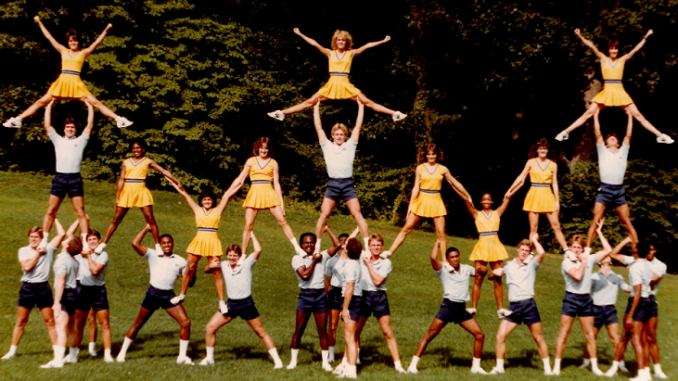
History of Cheerleading: Organizations and Publications, Then and Now: A Brief History of Cheerleading.
As stunting became part of the competitive aspect of cheerleading, so did the pressure to reach a certain level of creativity and difficulty. Although these advancements made stunting that much more entertaining and breathtaking, they also became more dangerous. Injuries were becoming more likely with stunting and cheerleading was labeled as one of the most hazardous activities for young athletes. Since cheerleading is not a sanctioned sport yet, individual governing organizations are responsible for creating and annually revising rules and regulations. While there is a general acceptance of the rulings from these organizations, it isnt uncommon for competitions to have their own set of stunting regulations banning some stunts and limiting others so that tossing, twisting and flipping can only be done in a certain way and at a certain height.

Lawrence Herkimer is one of the important figures that can be credited with makingstunting in cheerpopular. The clinics he held in the 1940s, now calledcheerleading camps, served as a place for new stunts to be developed and taught, and these stunts eventually spread throughout teams all over the US.
Since cheerleading was still growing, and was not a sanctioned sport, there were no regulated rules and guidelines that restricted the devleopement of new stunts. Eachcheerleading teamhad the freedom to branch out and use any moves they wanted to create new stunts. While this allowed cheerleading to progress with innovation, it also put the athletes in danger.
During the 1970s, cheerleading stunts really took off and began progressing from thigh stands to fulls. Pyramids debuted, which involved a large part of the team and and demanded strength and synchronization. Asbasket tossesand pyramids started appearing asstandard cheer routine stunts, it was clear that the skill level and athleticism expected from sideline and competition cheerleaders was changing.
Jessica loves French fries almost as much as she loves using her experience as a gymnast, dancer, team athlete, and camp counselor to help you become a better cheerleader.
By the 1980s competitive teams, now known asAll Star teams, were created in the United States. These teams focused on competitions exclusively, and combined gymnastics, stunting and dancing. When ESPN began broadcasting cheerleading competitions nationally, it was these All Star teams that helped usher cheerleading and its stunting element into main stream America. As the popularity of cheerleading spread, All Star teams created more cutting-edge stunts; the skill level these teams reached was phenomenal.
In the 1990s, other areas of cheerleading were being manipulated. Spring floors were introduced, and the competition mat size increased which made room for bigger and better stunts. Basket tosses now involved twists and flips. The simple liberty had transformed and now aflyer showed off her flexibilityby performing scales, bow-and-arrows and scorpions.
When cheerleading first began, the main goal was all aboutbuilding team spirit. When stunting was incorporated into sideline chants and cheers as a new way to entertain the fans, it also allowed cheerleaders to show a new level of talent and be recognized in a different and innovative way.
One thing is for sure; cheerleading would not be what it is today without the inclusion of stunting. New stunttrendsand techniques debut annually, along with new regulations, which keeps the platform of cheerleader on a constantly changing path.
Leave a Reply
You must be logged in to post a comment.